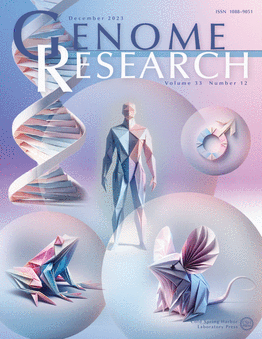The genomic consequences and persistence of sociality in spiders
IF 6.2
2区 生物学
Q1 BIOCHEMISTRY & MOLECULAR BIOLOGY
引用次数: 0
Abstract
In cooperatively breeding social animals, a few individuals account for all reproduction. In some taxa, sociality is accompanied by a transition from outcrossing to inbreeding. In concert, these traits reduce effective population size, potentially rendering transitions to sociality ‘evolutionarily dead-ends’. We addressed this hypothesis in a comparative genomic study in spiders, where sociality has evolved independently at least 23 times, but social branches are recent and short. We present genomic evidence for the evolutionary dead-end hypothesis in a spider genus with three independent transitions to sociality. We assembled and annotated high-quality, chromosome-level reference genomes from three pairs of closely related social and subsocial Stegodyphus species. We timed the divergence between the social and subsocial species pairs to be from 1.3 to 1.8 million years. Social evolution in spiders involves a shift from outcrossing to inbreeding and from equal to female-biased sex ratio, causing severe reductions in effective population size and decreased efficacy of selection. We show that transitions to sociality only had full effect on purifying selection at 119, 260 and 279 kya respectively, and follow similar convergent trajectories of progressive loss of diversity and shifts to an increasingly female-biased sex ratio. This almost deterministic genomic response to sociality may explain why social spider species do not persist. What causes species extinction is not clear, but could be either selfish meiotic drive eliminating the production of males, or an inability to retain genome integrity in the face of extremely reduced efficacy of selection.蜘蛛社会性的基因组结果和持久性
在合作繁殖的群居动物中,少数个体负责所有的繁殖。在一些分类群中,社会性伴随着从异种杂交到近亲繁殖的过渡。同时,这些特征减少了有效的种群规模,潜在地使向社会性的转变成为“进化上的死胡同”。我们在蜘蛛的比较基因组研究中解决了这一假设,蜘蛛的社会性已经独立进化了至少23次,但社会分支是最近的,而且很短。我们提出的基因组证据进化的死胡同假设在一个蜘蛛属与三个独立的过渡到社会性。我们从三对密切相关的社会性和亚社会性剑蜥物种中收集并注释了高质量的染色体水平参考基因组。我们将社会性和亚社会性物种对的分化时间定为130万年到180万年。蜘蛛的社会进化包括从异种杂交到近亲繁殖,从性别比例平等到性别比例偏向女性,导致有效种群规模严重减少,选择效率下降。我们的研究表明,向社会性的过渡分别仅在119、260和279 kya时对净化选择产生充分影响,并遵循类似的趋同轨迹,即多样性的逐渐丧失和向日益偏向女性的性别比例的转变。这种几乎是决定性的基因组对社会性的反应可以解释为什么社会性蜘蛛物种不会持续存在。导致物种灭绝的原因尚不清楚,但可能是自私的减数分裂驱动消除了雄性的产生,或者是在选择效率极度降低的情况下无法保持基因组的完整性。
本文章由计算机程序翻译,如有差异,请以英文原文为准。
求助全文
约1分钟内获得全文
求助全文
来源期刊

Genome research
生物-生化与分子生物学
CiteScore
12.40
自引率
1.40%
发文量
140
审稿时长
6 months
期刊介绍:
Launched in 1995, Genome Research is an international, continuously published, peer-reviewed journal that focuses on research that provides novel insights into the genome biology of all organisms, including advances in genomic medicine.
Among the topics considered by the journal are genome structure and function, comparative genomics, molecular evolution, genome-scale quantitative and population genetics, proteomics, epigenomics, and systems biology. The journal also features exciting gene discoveries and reports of cutting-edge computational biology and high-throughput methodologies.
New data in these areas are published as research papers, or methods and resource reports that provide novel information on technologies or tools that will be of interest to a broad readership. Complete data sets are presented electronically on the journal''s web site where appropriate. The journal also provides Reviews, Perspectives, and Insight/Outlook articles, which present commentary on the latest advances published both here and elsewhere, placing such progress in its broader biological context.
 求助内容:
求助内容: 应助结果提醒方式:
应助结果提醒方式:


